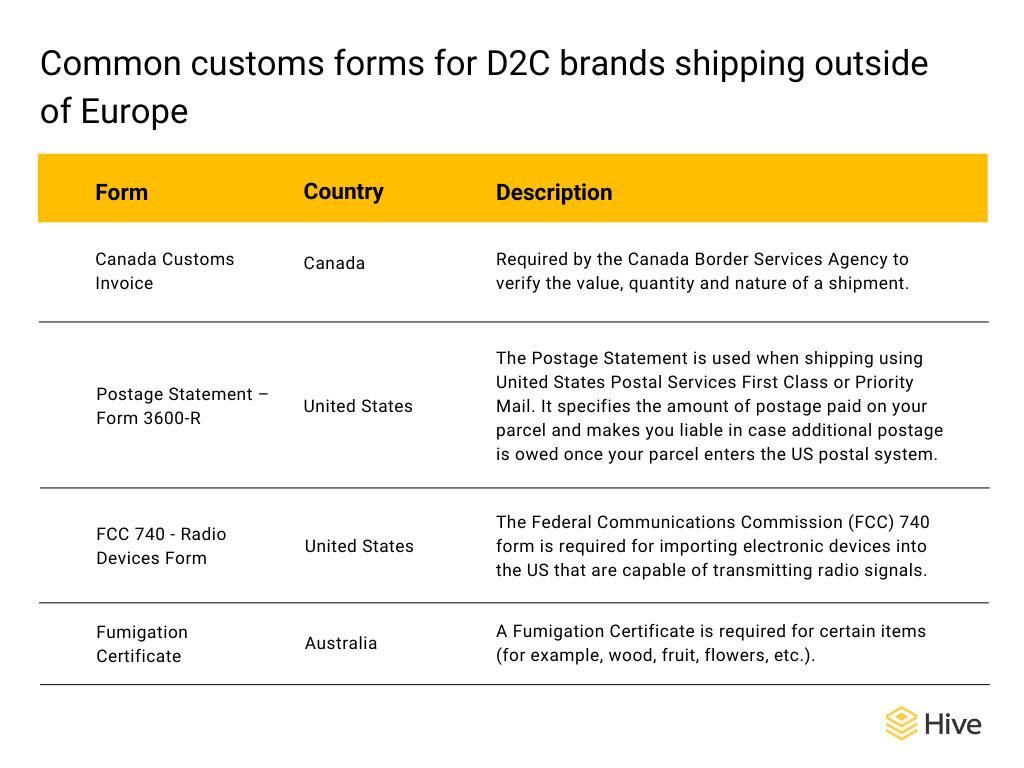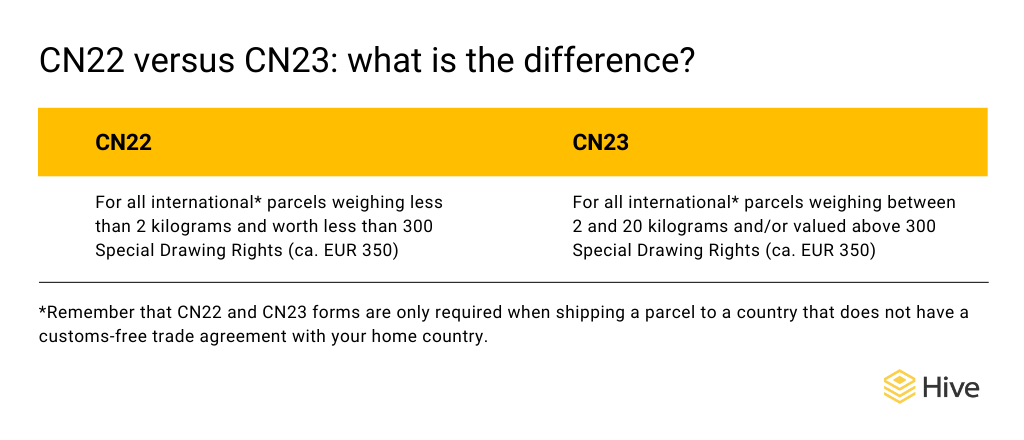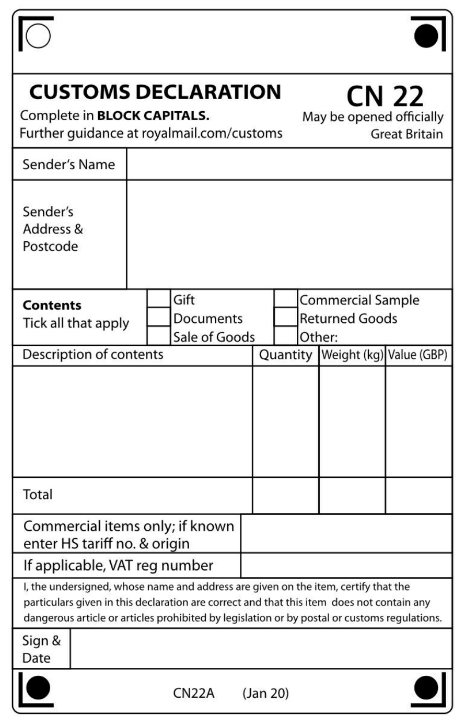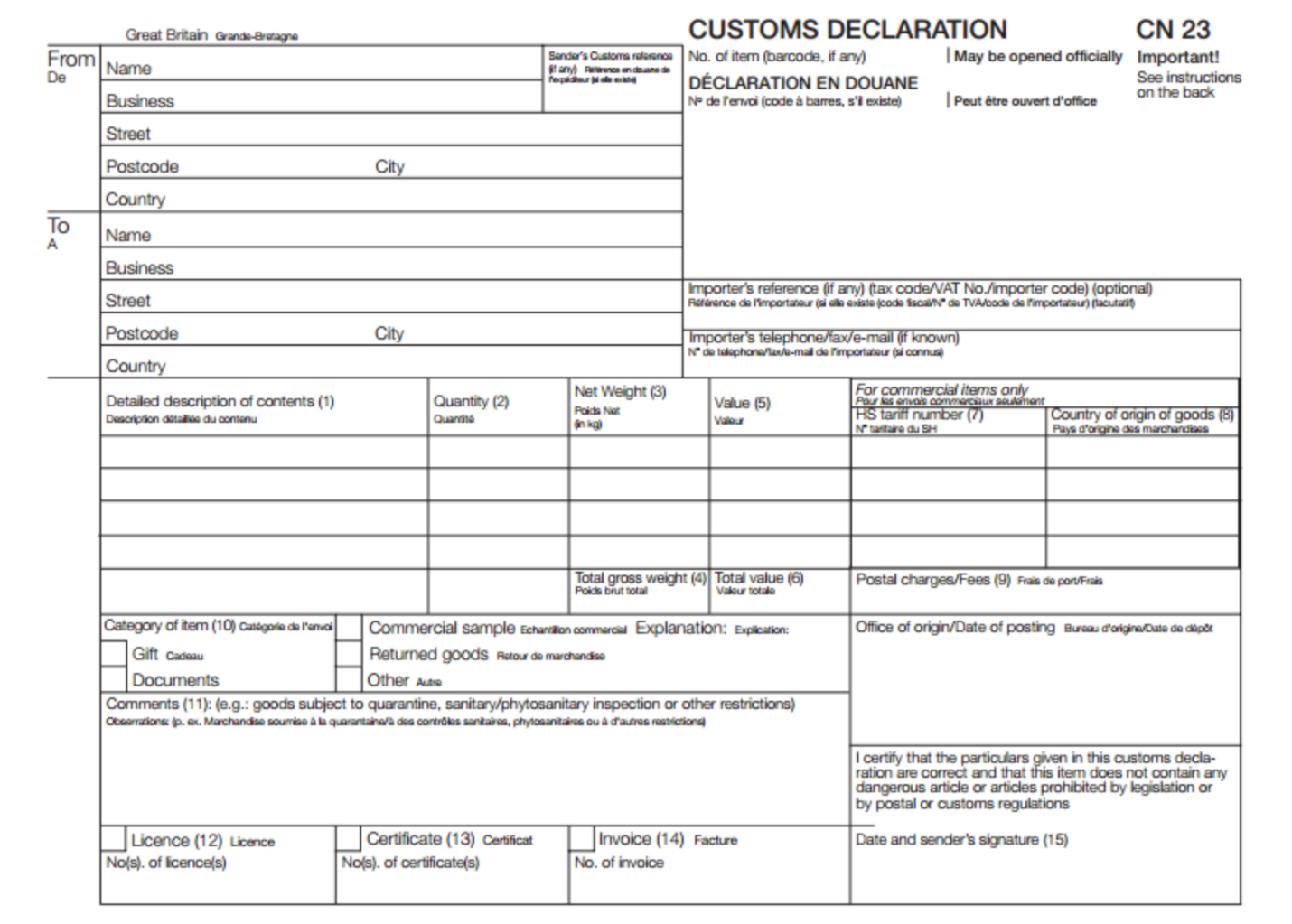A quick guide to customs forms: CN22, CN23, and other important documents
Find out which customs declaration you need for your shipment, and how to fill in the CN22 and CN23 forms.
.png)
As an e-commerce retailer, international shipping is a major driver for your business’ growth. But understanding which customs regulations apply to you can be a challenge. How can you ensure your shipments comply with the relevant customs requirements? And when and how do you use important customs documents like the CN22 and CN23 forms?
Below, we help you navigate the most important customs documents that you will need to use when shipping your merchandise across international borders. This blog should not be taken as legal advice, but rather as a guide to help you navigate international shipments.
Here are the topics we will cover:
- When to use customs declarations
- Which customs forms to use
- European Union customs rules and Brexit
- A deep dive into the most important customs forms: CN22 and CN23
- A step-by-step guide to filling out CN22 and CN23 forms
- How can I simplify the process? Working with a 3PL partner

When do I need to use a customs declaration form?
Any time you ship merchandise across international borders that are not subject to a customs-free trade agreement, you must use a customs form (sometimes also called a “customs declaration” or “customs document”). The most common of these are the CN22 and CN23 documents.
This means you do not have to use customs forms to ship from one EU member state to another (because the EU member states have a customs-free trade agreement). However there are some exceptions and you need a customs declaration when:
- Shipping to an overseas region of an EU country which is part of the EU but not in the Customs Union, e.g. Ceuta and Melilla.
- Shipping to overseas regions of EU countries which are part of the EU and Customs Union but have different VAT requirements, e.g. Canary Islands and French overseas territories.
To ship from an EU state to a non-EU state outside the customs union, you must attach customs forms to your parcel. The same applies if you are shipping a parcel from a non-EU country to an address inside the EU.
In short, you must use customs documents when:

These rules apply to all commercial shipments (e-commerce deliveries, for example), and they even apply to personal shipments (such as gifts between individuals).
What is the purpose of customs documentation?
Customs forms help national governments maintain an overview of which goods are entering their countries. This information is used for many reasons, including:
- Monitoring trade volume between two countries
- Tracking hazardous materials or items that pose a risk to public health
- Ensuring correct taxation
How does Brexit affect customs documentation?
Since January 1, 2021, all parcels shipped between the United Kingdom and any European Union member state must have customs documents attached.
An exception is made for goods shipped between Northern Ireland and the EU. However customs declarations may be needed for shipping between Northern Ireland and the rest of the UK. More info on Brexit and customs here.
What if I do not enclose the right customs form?
Because it is a legal requirement, it is important to always use the correct customs forms. Failure to provide a required customs form—or using the correct form, but including false or incorrect data—can have the following consequences:
- Your shipment may be delayed due to a customs inspection
- The contents of your parcel may be confiscated or destroyed by customs authorities
- The shipment may be returned to you at your expense
- You may be fined or, depending on the severity of the situation, criminally prosecuted
In short, failing to use customs forms correctly is not worth the risk. As the seller, it is your responsibility to ensure that the forms are used correctly. This means you are also legally liable in case of any errors or omissions.

Which customs forms and documents do I need to use?
There are many different customs forms and documents to use. The correct documents for you to use depends on factors like:
- The value of the items you are shipping
- The type of items you are shipping
- The carrier and delivery service you are using
- The country you are shipping to
Here are the most common customs forms and documents involved in international shipping for e-commerce retailers:
CN22 and CN23 forms
The CN22 and CN23 forms are the most common customs documents used in international shipping. They are a standard form created by the Universal Postal Union (UPU), a global alliance of postal service operators.
You must always use one of these forms when shipping parcels internationally using a national postal service (like Royal Mail in the UK or Deutsche Post in Germany).
It is also recommended to use a CN22 or CN23 form when shipping with private carriers (like DHL, UPS, FedEx or DPD). Because of their standardized format, they are recognized by customs authorities around the world. This means they can be processed more efficiently than non-standardized customs documents.
See the sections about CN22 and CN23 forms further below for a detailed explanation of these important forms.
Other common customs forms
Here are some other common forms you may have to use, depending on which country you are shipping to:

Deep dive: CN22 and CN23 forms
For most retailers, CN22 and CN23 forms are the most important customs documents you will use.
In the sections below, we explain:
- The difference between these forms and when to use each one
- How to fill them out

Where can I receive a CN22 or CN23 form?
These forms are available for you to download on the website of the national postal service in your country. If you are using a private courier, visit their online forms library or request the forms from their customer support department.
Who has to fill out a CN22 or CN23 form?
The shipper. If you are sending a parcel internationally, it is your responsibility—and your legal liability—to enclose a correct CN22 or CN23 form.
What do I do with the completed CN22 or CN23 form?
The completed form must be handed over to the postal service along with the parcel.
It can be affixed to the parcel in clear plastic wrap, so it is visible to the customs authorities in the destination country.
How do I fill out a CN22 customs declaration form?
The CN22 form contains less detail than the CN23, so it is easier to fill out. It can be printed as a sticker and placed alongside the shipping address on the parcel.
This is what the CN22 form looks like:

If you are shipping a small parcel internationally from inside the UK, this is the form you will have to fill out.
- Be sure to fill out the entire form, writing in clearly legible block capital letters.
- Enter your company’s name and address in the first two sections.
- As a retailer shipping an order to a customer, you will select Sale of Goods in the third section of the form.
- Enter a description of the contents. For example, if you are shipping a men’s printed T-shirt, you should specify the material: “men’s cotton shirt”. Also fill out the quantity, weight and retail value.
- Note that it is not necessary to enter HS codes if you do not know them. However, you will have entered those codes on your commercial invoice. This means you do know them, so they should be entered on the CN22 form too.
- Enter your company’s VAT number if you are registered to levy value-added tax in the UK or EU.
- Sign and date the form.
- Hand the completed form over to your postal service along with the parcel.
How do I fill out a CN23 customs declaration form?
Here is what the CN23 form looks like:
As you can see, the CN23 form is more detailed. Below is a step-by-step guide to filling out the form.

- Enter the address information for your company and the customer/recipient.
- Enter the customer’s VAT number (if they have one) and their telephone number.
- Provide detailed descriptions of each item. If you are sending items like cosmetics, it is not necessary to include the entire list of ingredients. Provide enough information to make clear what the items are; for example: “alcohol-free face cream”
- Enter the quantity, weight and value of each item. This information is mandatory and must be accurate.
- Enter the HS code and country of origin for each item.
- Enter the amount you paid for postage for this parcel.
- As the category, select “Other” and enter “Sale of Goods”.
- Enter the location of the post office and date of posting.
- Enter any comments that might be relevant to the products you are sending (whether they must be quarantined upon arrival, for example). If you are not sure, check the website of the customs authority in the country you are shipping to or consult with a customs broker.
- If any special licenses or certifications are required for your items, enter their reference numbers.
- Enter the invoice number for the customer’s order.
- Sign and date the CN23 form.
- Hand over the completed form to your postal service along with the parcel.

How can I simplify the customs process? Working with a 3PL partner
As you can see, customs forms like the CN23 require lots of details. It is time-consuming to fill out customs documents each time your company ships internationally. Still, you are required by law to do this. As your company grows, expanding internationally and widening your customer base will be important, and filling out these forms individually is not a scalable solution.
Handling your own customs documentation is not only time-consuming though. It is also risky. Even a small error or omission on a customs form can result in your parcel being delayed or returned as undeliverable. And in the worst case, it may even result in a fine or other penalties for your company.
Simplify your customs process by working with a full-service logistics management partner like Hive. We have the in-house expertise and experience to handle customs-related documents and procedures, no matter what you are shipping or where you are shipping it to. This is how it works:
- You receive an order from an international customer.
- The order is automatically sent to our international packing station.
- We take care of the entire customs declaration.
- We take responsibility for ensuring your customs documents are correctly filled out and submitted.
- You never have to worry about handling customs forms again, so you can focus on running your business instead.
Interested in working with Hive? Find out more about our pricing and request a quote here.









